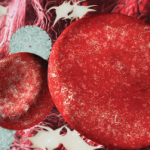Chances in the Tournament
FDG-PET in LVV opens the tournament against DECT in Gout, which looks like a match-up of two similarly minded teams whose game plans revolve around a vision—or image—of outside to inside to score the buckets (diagnosis). FDG-PET in LVV has an honorable mention in conference play (see the 2021 vasculitis guidelines), and DECT in Gout’s defense of preventing joint aspiration pales in the intense face of FDG-PET in LVV’s defense against the biopsy of a large artery.
FDG-PET in LVV’s future in the tournament is brighter than the vessels it images because of a team composition of youngsters with Takayasu arteritis and experienced vets with GCA. FDG-PET in LVV is the ultimate team player, bringing together rheumatologists, radiologists and nuclear medicine to develop the FDG-PET game plan.
However, the technology may still be a few years away from winning it all because of questions regarding its scouting ability—or FDG-PET’s role in monitoring and managing LVV. Unfortunately, it may be derailed from bringing all it has to offer to the table by insurance companies and cost.
Sean Carter, MD, is a first-year fellow in the Medical University of South Carolina Rheumatology Fellowship Program, Charleston.
Jessica English, MD, is a first-year fellow in the Medical University of South Carolina Rheumatology Fellowship Program, Charleston.
Brad Collins, DO, is a first-year fellow in the Medical University of South Carolina Rheumatology Fellowship Program, Charleston.
Ana Tucker, MD, is a second-year fellow in the Medical University of South Carolina Rheumatology Fellowship Program, Charleston.
Jen Schmidt, MD, is a second-year fellow in the Medical University of South Carolina Rheumatology Fellowship Program, Charleston.
Whitney Elg-Salsman, DO, is a third-year fellow in the Medical University of South Carolina Rheumatology Fellowship Program, Charleston.
Faye Hant, DO, is fellowship director of the Medical University of South Carolina Rheumatology Fellowship Program, Charleston.
References
- Grayson PC, Alehashemi S, Bagheri AA, et al. 18F-fluorodeoxyglucose-positron emission tomography as an imaging biomarker in a prospective, longitudinal cohort of patients with large vessel vasculitis. Arthritis Rheumatol. 2018 Mar;70(3):439–449.
- Quinn KA, Ahlman MA, Malayeri AA, et al. Comparison of magnetic resonance angiography and 18F-fluorodeoxyglucose positron emission tomography in large-vessel vasculitis. Ann Rheum Dis. 2018 Aug;77(8):1166–1171.
- de Boysson H, Dumont A, Liozon E, et al. (2017). Giant-cell arteritis: Concordance study between aortic CT angiography and FDG-PET/CT in detection of large-vessel involvement. Eur J Nucl Med Mol Imaging. 2017 Dec;44(13):2274–2279.
- Tawakol A, Migrino RQ, Bashian GG, et al. In vivo 18F-fluorodeoxyglucose positron emission tomography imaging provides a noninvasive measure of carotid plaque inflammation in patients. J Am Coll Cardiol. 2006 Nov 7;48(9):1818–1824.
- Nielsen BD, Tønder Hansen L, Keller KK, et al. Attenuation of fluorine-18-fluorodeoxyglucose uptake in large vessel giant cell arteritis after short-term high-dose steroid treatment—a diagnostic window of opportunity [abstract: 3182]. Arthritis Rheumatol. 2016 Oct;68[suppl 10].



